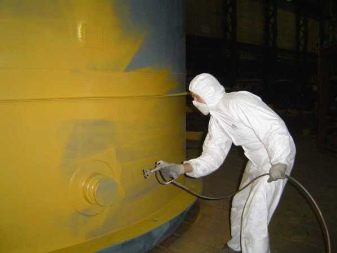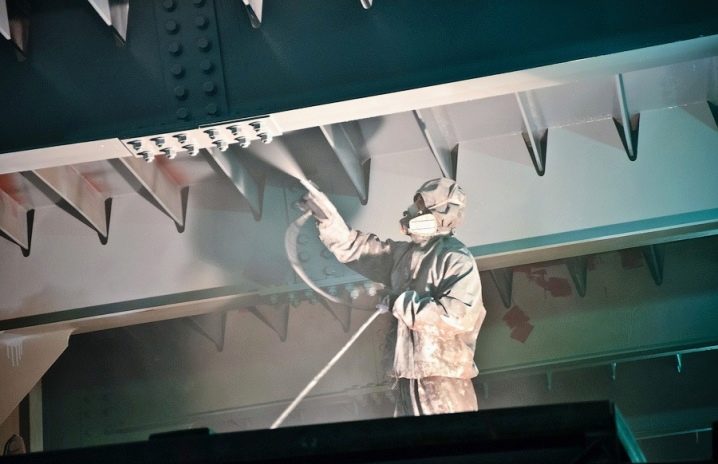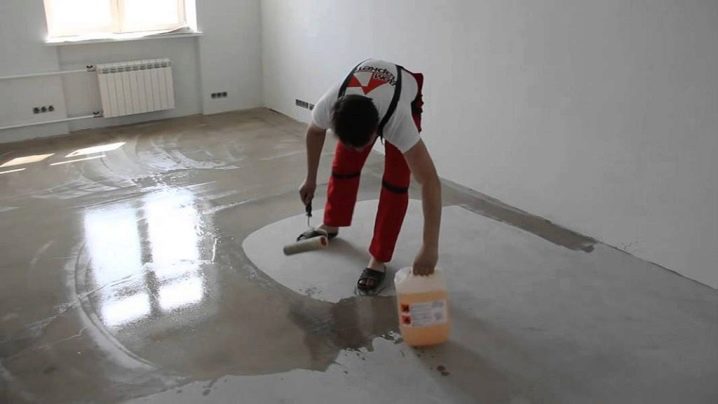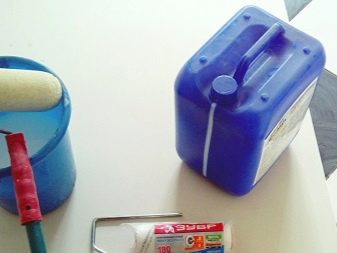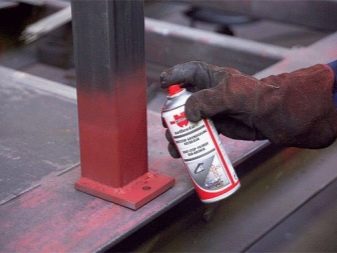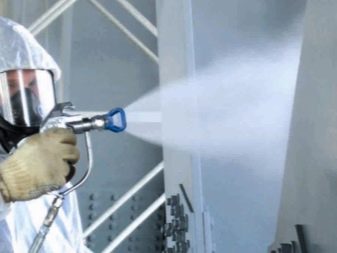Features of the choice of epoxy primer

Epoxy primer - a material with which you can create a coating that provides effective surface protection against corrosion. That is why he won great popularity among consumers. This coating is a “foundation”, the rest of paints and varnishes are applied on it.
After reading this article, you will learn about the technical characteristics, features of the choice of such primers, get an idea of their pros and cons.
What it is?
Many people buy an epoxy primer to avoid rust on metal surfaces.Such materials are often used for application to vehicles. They are well suited for light alloys, galvanized surfaces, ferrous and non-ferrous metals.
Epoxy primer formulations are based on a special high-quality resin. They also include polyamines (active additives), which have unique chemical properties.
Similar compositions differ in universality. They can be used as thermoplastic insulators, fillers.
Species
All epoxy based primers can be divided into two groups:
- compositions for metal surfaces;
- compositions for concrete foundations.
It is necessary to understand in detail the features of each type.
For metal surfaces
Such primers are very reliable, they are even used for surface treatment in industrial facilities. If you want to choose a composition that is of good quality, you need to know how it should be.
The advantages of the compositions for the metal
High-quality materials for metal surfaces have the following advantages:
- Coatings must reliably protect surfaces from mechanical effects,provide abrasion resistance. A sign of insecurity and poor quality primer - low coating strength.
- If you focus on standards, it can be noted that the primer should protect the surface from corrosion for five years (no less). Of course, this can only be achieved if the base is carefully prepared before applying the material.
- High-quality epoxy primers for metal surfaces are resistant to petroleum products.
Because of this, they can be used at gas stations, in workshops and other similar places.
- Good epoxy primers are resistant to alkalis and acids. This is a very important advantage: it is a guarantee that the foundation will be reliably protected even in the event that unforeseen circumstances arise.
- Dried coating should be absolutely safe for human health. Such materials are always certified, they have very strict requirements. If there are no documents confirming the quality of the material, it is better not to purchase it.Otherwise, you can get a low-quality primer that will not provide reliable surface protection.
- If you are not sure that you will be able to orient in the variety of materials on the current market, it is better to get advice from an experienced specialist. It is also worth trying to get as much information as possible about the manufacturer of the primer composition of interest.
- In those cases when you need to use epoxy primer indoors, it is better to stop the choice on the version without solvents. This will allow the primer to be applied without fear of poisoning. In other cases, compositions with solvents are fine: they are usually of high quality and more affordable cost.
- Epoxy primer is combined with many coloring compounds. Thanks to the universality of such materials, you can be sure that the result will not disappoint in the end.
Other distinctive features
Epoxy primer for metal is most often applied in 3 layers. This amount of primer is enough to ensure reliable protection of the surface for several years.
Primers for metal surfaces are two-component. They consist of components that contribute to the improvement of the protective properties of the coating and increase its strength, as well as epoxy base. It is necessary to add a hardener to the solution.
For plaster and concrete
Such priming materials are divided into two-component and one-component. It is worth more to understand the features of each type.
Single component
These primer formulations have the following features:
- Ease of use. You will not need to worry about how to properly prepare the solution. No need to think about the accuracy of proportions: such materials can be used immediately.
- Single component primers are fire safe. You do not have to fear that the coating will catch fire.
- Such coatings protect wood surfaces from the effects of liquids. You can not buy impregnation - and thereby save money.
- These primers provide good adhesion. With the help of a one-component primer, even surfaces that are poorly absorbed can be prepared for finishing: painted constructions, ceramic bases, and so on. Such compounds are suitable for PVC, linoleum.
Bicomponent
Consider the distinctive features of two-component primers.
- They should not be applied to damp substrates. Otherwise, the reliability of the material will be significantly reduced, as the adhesion will deteriorate.
- The surface usually dries within twenty four hours. To load the coating is fully prepared in a week. Do not expose the surface to loads too early, the coating can not withstand them.
- Very high strength provides excellent penetrating power. Such coatings almost never crack or peel.
- Two-component primers are characterized by high wear resistance. Due to this, their performance properties are retained for the longest possible term.
The standard two-component primer for concrete surfaces is very well suited for self-leveling floors. There are also "fast" compositions that are used for the rapid processing of concrete.
Zinc-rich
This primer is suitable for application to steel surfaces. Such primers are resistant to various chemical solutions, oils, liquids. They are characterized by increased resistance to abrasion.The color of such primer coatings is gray. Zinc-rich epoxy primers can be used as stand-alone coatings.
disadvantages
Epoxy primers also have certain disadvantages. Such coatings dry long enough. Even if you take into account all the recommendations when processing the surface, the absolute drying will take at least twelve hours. Often it takes at least a day.
It is not recommended to dry the primed base forcibly. - Otherwise, bubbles may appear on the surface. Another disadvantage of this method of drying is the unevenness of drying of the layers. This coating will not be durable.
How to choose?
Choosing the most suitable epoxy primer should be taken as seriously as possible. If you do not know how to determine the manufacturer and type of primer, it is better to seek help from specialists.
In the event that it is not the first time when you carry out finishing work with your own hands and you already have some experience in using epoxy primers, you can focus on your own preferences.
If the work is shallow, you can stop the choice on the aerosol. It acts quickly, is easy to use.
Materials in cans
The epoxy primer in the canister has certain advantages.
- The primer that remains in the cartridge after the first use can be applied as many times as you need. However, after the completion of the finishing work will need to clean the spray from the remaining primer.
- The jet can be very thin (if you have certain skills). Thanks to this, an aerosol primer can even handle very complex surfaces, hard-to-reach places.
- Such an epoxy primer can be prepared for use as soon as possible. You only need to shake the balloon a few times (this should be done quite strongly).
The nuances of the use of aerosol means
Conventional two-component primers are most often prepared with a margin. Then you have to think about where to put the remaining composition. After some time, such material freezes in any case, so it will be impossible to re-use it.There are no such problems with aerosol primers. Although they can be quite expensive, you can still save money by avoiding significant material consumption.
However, it should be borne in mind that spray primers can not be stored for very long (in contrast to the two-component variants). It is not recommended to remove such compounds in the basement or garage and forget about them for several years. The term of their use is limited. We should not forget that they are designed for small areas.
Since the surface needs to be prepared before using primers, the ease of using an aerosol primer composition does not mean that, for example, scratches on the car can be processed directly on the street immediately after the occurrence of the defect. Usually this leads to the fact that the surface must be primed again.
However, in the presence of a salty liquid and hot weather, it is better to cover the scratches on the car with an epoxy aerosol spray primer.
When you go to the workshop, this coating will be removed, but it will protect the surface from hidden salt corrosion.
How to prepare the foundation?
In this regard, epoxy primer compositions are quite unpretentious: you do not have to carry out a long and very thorough preparation of the surface. However, it is necessary to prepare the base, otherwise the material may be worse to mate.
Remove dust and dust from the surface, let it dry before applying the primer.
Soil preparation
It is necessary to mix the hardener and epoxy resin, which is the basis. Then you should get a homogeneous consistency (by thoroughly mixing the material).
If there are lumps in the primer, it is quite possible that the coating will then begin to peel off from the surface.
Preparation of the mixture is recommended to start half an hour before applying it to the substrate.
Preparing the composition, you need to consider what exactly you will put it. If a paint brush or roller is used as a tool, the material can be quite viscous. In the case of the use of the spray gun it is worth using a special solvent so that the primer can be easily applied to the surface.
In order not to prepare too much primer at once, it is worthwhile to pre-calculate how much primer is needed for two-hour work. If you do not have time to use the entire composition, the residues may harden.
Drawing
Different tools can be used to apply the primer. It is necessary to wait for the absolute drying of the layer before applying the next. The thickness of the layers varies: it depends on the functions to be performed by the primer, as well as on the condition and type of substrate.
Grind the last layer thoroughly.. In that case, if you plan to paint not a primer, but a putty, you can not polish the finishing layer.
After applying the primer, you will need to rinse all the tools that you used. This can be done with a solvent. Especially carefully you need to wash the spray guns., because of the frozen primer composition such a tool will not be possible.
Precautionary measures
Applying an epoxy primer, you need to remember certain rules.
- If you use a spray gun to apply a primer to the elements that conduct an electric current, you need not direct and do not approach the stream to them.
- Do not apply primer near sources of fire.
- Remember to use personal protective equipment.When working with epoxy primer material, it is necessary to protect the respiratory tract, eyes, and skin.
Today, manufacturers of primer formulations offer a variety of options. If you are going to purchase material, carefully read the information on the package, pay attention to the characteristics of the primer. It should be remembered that all manufacturers and the primers themselves have their own characteristics.
If you select a suitable epoxy primer as thoroughly as possible, the results will not disappoint you: the service life of the coating will be very long.
The scope of epoxy primer is discussed in the following video.





